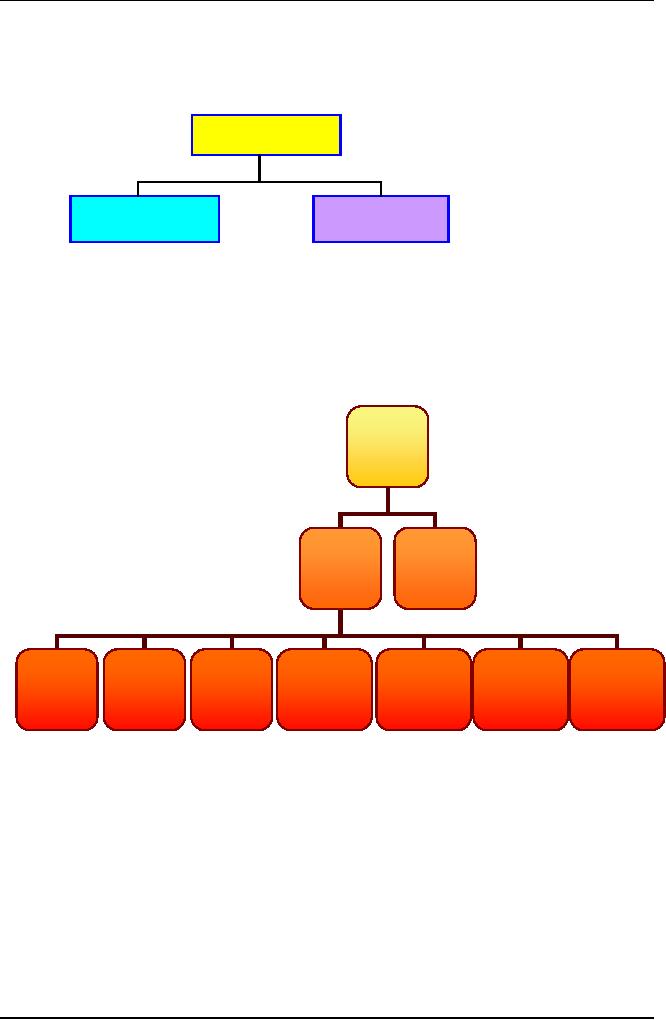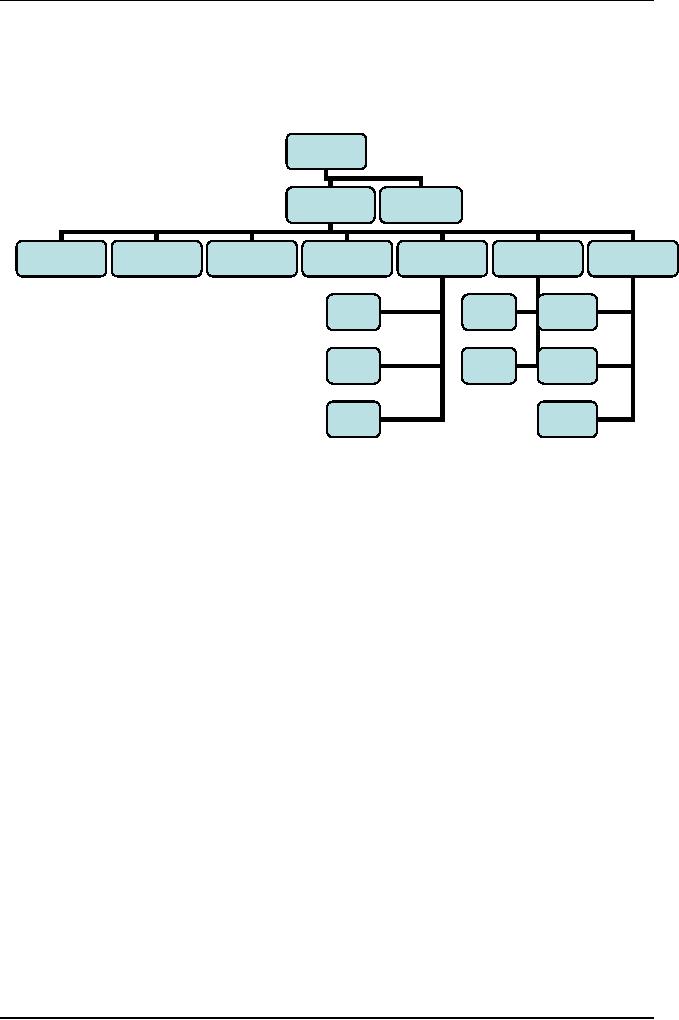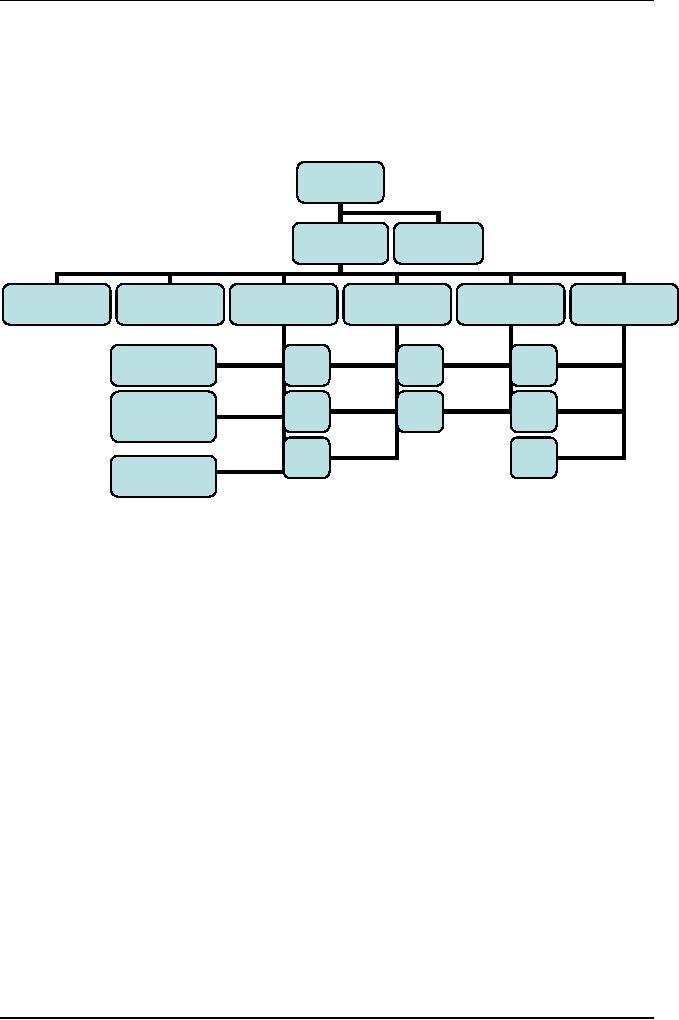 |
Team leader, Project Organization, Organizational structure |
| << Project Management’s nine Knowledge Areas |
| Project Execution Fundamentals Tracking >> |

Software
Project Management
(CS615)
LECTURE
# 6
1.
Introduction &
Fundamentals
1.17
Team
leader
Most
definitions of leadership involve
three components: influence group
and
goal. First,
leaders are individuals who
influence
the
behavior of others. These
others
are usually referred to as sub
ordinates or followers. Second,
leadership is
usually
examined in the context of a
group,
especially
work groups such as
managers
and their teams or foremen and
their subordinates. Third,
research on
leadership
stresses a group goal
that
has to be accomplished. So a definition
is:
Leadership
is the process in which an individual
influences the group
members towards
the attainment of group or organization
goals.
Note
that the influence
can
be exercised in a: variety of ways. It
may be the
'bridge
to engine room' approach, where
the leader commands and controls.
Or
the
influence can be exercised by guiding and
facilitating the group's
behavior so
that
the goal is accomplished.
The notion of reciprocity
is
also part of man
definitions.
Influencing is often two
ways. Leaders may influence
followers, but
followers
influence leaders to lead in one way
rather than another. An
influencing
style
appropriate for checkout
assistant in a supermarket may be
different from
that
appropriate for rock
scientists. The choice is open to
the leader of how to
influence
is one of the key aspects
investigated by leadership
researchers.
Another
aspect of leadership is that
the right to lead is often
voluntarily
conferred
on the
leader by some or all members of the
group. A group of friends
may
recognize
one, of their group as the
leader, in the sense that
she influences the
group
more than any of the
other members. There also may be
informal leader.
While
the nominal head of a
department may have the
formal leadership
position,
the
real leadership may be exercised by
someone lower down the
hierarchy who
influences
the group towards goals that
may not be those that the
organization
whishes
to be pursue.
Finally,
leadership implies that
a leader motivates the group to spend
energy
in
attaining the goals of the group.
Influence without change or movement
isn't
influence.
Leaders make change happen, a difficult
but vitally important
task.
1.18
Leaders and
Managers
Although
it is common to use the
terms 'leader' and 'manager'
interchangeably,
nowadays
many writers point to a
difference between the
two.
44

Software
Project Management
(CS615)
The
difference is that to function as a
leader, a person must exercise
influence
over
another person in the attainment of
organizational goals, as described in
the
definition
above. Managerial ' functions of
organizing, planning,
scheduling,
processing
information, communicating, and so on, do
not necessarily
involve
leadership.
Some managers perform both
types of function and can be
described
as leaders,
but others do not. There is
no automatic link between
the two concepts.
Note,
too, that leaders are
not necessarily just at the
top of organizations.
Influence
can be exerted in most job
functions and at levels of seniority
or
hierarchy.
The distinction between
managers and leaders was,
developed by
Bennis
and Nanus (1985) in their
influential book Leaders.
In it
they put forward
the
view that:
Leadership
is path finding
Management
is path following
Management
is about doing things
right
Leadership
is about doing the right
things
What
they meant by this is that
leadership is about having a
vision. It involves
having a
strategy or thinking strategically; it
means having a view of where
the
organization
should go or be or do; it means
deciding what is important
for the
success
of the organization; it involves
envisaging the future, A
leader's
responsibility
is to think what are the
key criteria for success of
his or her part of
the
business and not just now
but for the
future.
Managers,
on the other hand, are
more concerned with
implementing others
strategies
and plans, They are
concerned with running their
part of the
organization,
making sure that the
accounts get prepared, that invoices
are sent
out,
that the service is sold,
that the traffic is
directed, that the research
paper is
written,
or whatever the task that
needs to be done.
A very
similar view is put forward
by Kotter (1990). He argues
that management
is
concerned with activities
which are designed to
produce 'consistency and
order',
whereas
leadership is concerned with,
'constructive or adaptive change'.
Kotter
says
there are four major
ways that management and leadership
differ:
1. Planning
and budgeting versus establishing
direction. Management
involves
making detailed steps and
timetables for achieving
results, then
marshalling
resources to make it happen. Leadership
means developing a
vision
of
the
future and strategies for
achieving that
vision.
2. Organizing
and staffing versus aligning
people.
Management
comprises the
allocation
of
tasks in
line with plans, staffing
them appropriately,
delegating
responsibility
and monitoring implementation. Leadership
involves
communicating
the vision so that others
understand and agree with
it.
3. Controlling
and problem-solving versus motivating and
inspiring.
Management
involves monitoring results of a
plan, identifying problems
with
the
plan and then solving them.
Leadership involves 'energizing
people'
45

Software
Project Management
(CS615)
towards
the vision. It means
appealing to their needs and
values so that they
overcome
barriers to change.
4. Outcomes:
predictability and order, or change.
Management
produces
predictability
and order so that others,
such as customers or shareholders
can
rely on
consistent results. Leadership produces
change that is often a
quantum
leap,
such as new products or new
approaches to managing people, that
makes
the
organization more
competitive.
Kirkpatrick
and Locke (1991) suggest
that the following traits
distinguish
leaders
from non-leaders:
�
Drive
(achievement. ambition, energy, tenacity,
initiative);
�
Leadership
motivation (personalized or socialized);
.honesty and
integrity;
�
Self-confidence
(including emotional
stability);
�
Cognitive
ability (the ability to
marshal and interpret a wide
variety
of
information);
�
Knowledge
of the business
They
point out, though, that
there is much more to being
an effective leader than
merely
possessing a list of traits.
While the traits may
provide people with
the
potential
for leadership, it is the
capacity to create a vision and
implement it that
turns
the potential into
reality.
Strong leadership
motivation may
sound an obvious trait for a
leader. After all,
only
those who want the weighty
responsibilities and grueling pressures
of
leadership
are likely to strive for
it. McClelland (1985)
distinguishes between
two
types of
power motivation. On the one
hand, leaders may be
interested in
personalized
power, which
describes the motivation of
leaders who "seek
power
for
its own sake, who
wish to dominate others and
are often concerned with
the
status and
trappings of power. The late
Robert Maxwell, former owner
of the
Mirror
Group allegedly displayed
such traits. On the other
hand, leaders who
show
socialized
power motivation
are more interested in
cooperating with
others
to
achieve desired goals. They
work with others rather
than attempting to
dominate
or control them. From the
point of view of subordinates and
the
organization
as a whole, the leader motivated by
socialized power is
obviously
preferable.
On the question of cognitive
ability; leaders must be able to
gather,
integrate
and interpret large amounts of
information. Many
Many
researchers have pointed out
that it is not necessary to be
brilliant, though;
leadership
effectiveness is helped by above average
intelligence, not genius.
Of
Kirkpatrick
and Locke's six characteristics,
some would argue that drive
and
persistence
are much more important
than intelligence.
In
conclusion, the trait approach
has undergone a revival.
Recent research
suggests
that traits do matter. Yet
the research shows that
there are only a
handful
46

Software
Project Management
(CS615)
of traits
which distinguish leaders
from others, and a clear
distinction between
effective
and ineffective leaders has
not yet emerged.
In an
excellent book of technical
leadership, Jerry Weinberg
suggests a MOI
model of
leadership:
Motivation:
The
ability to encourage (by "push or
pull") technical people to
produce
to their best
ability.
Organization:
The
ability to mold existing
processes (or invent new
ones) that
will enable
the initial concept to be
translated into a final
product.
Ideas or
innovation: The
ability to encourage people to create and
feel creative
even
when they must work
within bounds established for a
particular soft- ware
product
or application.
Weinberg
suggests that successful
project leaders apply a
problem solving
management
style. That is, a software
project manager should concentrate
on
understanding
the problem to be solved,
managing the flow of ideas,
and at the
same
time, letting everyone on
the team know (by words
and, far more
important,
by
actions) that quality counts
and that it will not be
compromised.
Another
view [EDG95] of the
characteristics that define an
effective project
manager
emphasizes four key
traits:
Problem
solving An
effective software project manager can
diagnose the
technical
and organizational issues that
are most relevant,
systematically structure
a
solution or properly motivate
other practitioners to develop
the solution, apply
lessons
learned from past projects
to new situations, and remain
flexible enough
to change
direction if initial attempts at
problem solution are
fruitless.
Managerial
identity
A good
project manager must take charge of the
project. She must have
the
confidence
to assume control when
necessary and the assurance to
allow good
technical
people to follow their
instincts.
Achievement
To
optimize the productivity of a
project team, a manager must reward
initiative
and
accomplishment and demonstrate through
his own actions that
controlled risk
taking
will not be punished.
Influence
and team building
An
effective project manager must be able to
"read" people; she must be
able to
understand
verbal and nonverbal signals and react to
the needs of the
people
sending
these signals. The manager
must remain under control in
high-stress
situations.
47

Software
Project Management
(CS615)
1.19
Project
Organization
People
are managed through an
organizational structure. This
hierarchical
structure
is based on the four cornerstones of
management: delegation,
authority,
responsibility and supervision (see
Fig.1). Delegation bestows
authority,
and authority produces (and requires)
responsibility. Both
authority
and responsibility require supervision,
and effective supervision
requires
a suitable organizational
structure:
Most
projects are organized as
teams, with each team
assigned specific
functions
within the project,
Different types of project
require different
types of
team structure, as for example a team of
junior programmers
requires
a technical team leader while a team of
experts may require
only
an
administrative team leader. It is the
project manager's responsibility
to
select
the structure best suited
for the project.
Basically
an organization is a group of people
intentionally organized to
accomplish
an overall, common goal or
set of goals. Business
organizations
can range in size from two people to tens of
thousands.
Delegation
1
Supervision
2
Authority
Responsibility
3
4
Figure
1: The
four cornerstones of management
There
are many ways to organize a
software project. The larger
the project
the
more critical the
organizational structure becomes.
Badly organized
projects
breed confusion, and confusion
leads to project failure.
Figure 2
describes
the basic structure of a
project in which below the
project
manager
are just two general
functions: development and support.
This
very
basic software project
structure was not uncommon in
the 1950s and
1960s. It is
still a valid project
structure for very small
projects (up to five
developers),
though occasionally it can still be
found today in larger
projects.
48

Software
Project Management
(CS615)
Project
Project
Project
development
support
Figure
2: Basic
structure of a development
project
Project
manager
Deputy
Secretary
project
manager
System
Independent
Quality
Configuration
Development
Development
Development
engineer
test
group
assurance
control
team
1
team
2
team
3
Figure
3: Software
project organizational
chart
49

Software
Project Management
(CS615)
Project
manager
Deputy
project
Secretary
manager
Integration
Independent
Quality
Configuration
SW
sub-project
SW
sub-project
SW
sub-project
Manager
2
Group
Group
assurance
control
Manager
1
Manager
3
Team
1
Team
1
Team
1
Team
2
Team
2
Team
2
Team
3
Team
3
Figure
4: Large
hardware/software project organizational
chart
Project
managers are just two
general functions: development and
support. This very
basic
software project structure was
not uncommon in the 1950s
and 1960s. It is a project
structure
for very small projects
(up to five developers).
Though occasionally, it can
still
be found
today in larger
projects.
Figure 3
describes a detailed organizational
chart including all major
support functions.
This
organizational structure is suitable
for large projects (with a
staff exceeding 20).
Smaller
projects may not require a
deputy project manager or separate
configuration
control
and quality assurance
groups.
Very
large projects (exceeding a
staff of 40) can often be
managed more easily
by
dividing
the project into
sub-projects. Figure 4 presents
the organizational chart for
a
large
project. This chart includes
both software and hardware
development teams, and an
integration
group that is responsible for
hardware/software integration as well
as
integration
within each group.
As an
example, consider the
organization of a large satellite
project. The project
manager
is in
fact responsible for a
number of projects: the
ground control station, the
rocket and
the
satellite itself. The
software for all of these
sub-projects is managed within a
single
project
office. Each sub-project is then
managed by a sub-project manager.
An
organizational
chart similar to the one
described in Fig. 4 can be applied to
the satellite
project;
the resulting chart is
described in Fig. 5.
50

Software
Project Management
(CS615)
Satellite
PM
Sub-project
Secretary
Coordinator
Scientific
Integration
Ground
control
Rocket
Satellite
Quality
assurance
Development
Engineer
Team
Station
sub-project
Sub-project
Sub-project
Team
1
Team
Team
Quality
1
1
Assurance
Team
2
Team
Team
Independent
2
2
Group
Team
3
Team
3
Configuration
Control
Figure
5: Satellite
project organizational
chart
Clearly
the project's organizational
structure is dependent on the type of
project being
developed.
Some of the issues that
must be considered are:
Project
size: the larger the
project, the more important
the organization.
Large
projects
have significant human
communications and coordination overhead,
and
therefore
require more support
functions.
Hardware/software
development projects. The
simultaneous development of
hardware
and software is not easy.
Planning, integration and testing
are much
more
complicated, and require dedicated
support groups.
High
reliability systems. Any system that is
sensitive to issues of reliability
(such
as
military or life-saving systems)
requires a major effort in
quality assurance.
Quality
is also an important consideration in
many marketable software
products
(e.g.
communications packages). These types of
project require a separate
quality
assurance
organization.
51

Software
Project Management
(CS615)
The
Organizational structure
The
organization's structure, or design, is
the overall arrangement of
the
organization's
various roles, processes and
their relationships in the
organization.
The
design of an organization is a means
to
accomplishing the
organization's
overall
goal -- the structure is not
an end in itself. In systems theory
terms, the
design
ensures that the appropriate
inputs go through the
necessary processes to
produce
the required outputs to
produce the intended
outcomes.
The
structure of the performing
organization often constrains
the availability of or
terms
under which resources become
available to the project.
Organizational
structures
can be characterized as spanning a
spectrum from functional
to
projectized,
with a
variety of matrix structures in
between.
⇒ Corporate
structure: The
project's organization is largely
dependent on the overall
structure
of the company within which
the project is being
developed. Many of
the
project
support functions can be provided by
centralized groups within
the company.
In fact,
basic services, such as financial,
secretarial and legal services, are
commonly
provided
by the parent or corporate
organization.
Corporate
structure usually dictates one of two
basic types of project
organization:
matrix or
pyramid. Figure 5 describes
the structure of a matrix
organization (compare
this to
the pyramid structure in
Fig. 4). Within a corporate
matrix organization,
the
project
manager manages the technical
activities of the project
staff, while his or
her
involvement
in non-technical personnel issues
(e.g. salary reviews,
promotion, and
training)
is minimal.
⇒
Matrix
Structure
Think of
the functional structure.
Imagine if you took someone
from each of the
major
functions in the functional
structure (the boxes along
the bottom of the
organization
chart), e.g., people from
sales, engineering, etc., and
organized them into
a
separate group intended to
produce and sell one certain
kind of product or
service.
Members
of this group stay together
until that product is
produced or they continue
to
sell and
service it. This overall
structure (made up of a functional
structure that also
has
groups assigned to products) is a
matrix structure. This
structure is useful
because
it focuses
highly skilled people from
across the organization to
work on a complex
product
or service. It can be difficult though,
because each person essentially
reports
to two
supervisors: the supervisor of
the functional area (e.g.,
engineering) and the
product
manager, as well. When the
organization needs constant
coordination of its
functional
activities, then lateral
relations do not provide
sufficient integration.
Consider
the matrix structure. To adopt
the matrix structure
effectively, the
organization
should modify many
traditional management practices.
Matrix
organizations are a blend of
functional and projectized
characteristics. Weak
matrices
maintain many of the
characteristics of a functional
organization, and the
52

Software
Project Management
(CS615)
project
manager role is more that of a
coordinator or expediter than
that of a manager.
In
similar fashion, strong
matrices have many of the
characteristics of the
projectized
organization--full-time
project managers with considerable
authority and full-time
project
administrative staff.
Most
modern organizations involve
all these structures at
various levels. For
example,
even a
fundamentally functional organization
may create a special project team
to
handle a
critical project. Such a team
may have many of the
characteristics of a
project
in a projectized organization. The team
may include full-time staff
from
different
functional departments, it may
develop its own set of
operating procedures,
and it
may operate outside the
standard, formalized reporting
structure.
Matrix
Organizations are a blend of
functional and projectized
characteristics. Weak
matrices
maintain many of the
characteristics of a functional
organization, and the
project
manager role is more that of a
coordinator or expediter than
that of a manager.
In
similar fashion, strong
matrices have many of the
characteristics of the
projectized
organization--full-time
project managers with considerable
authority and full-time
project
administrative staff.
Most
modern organizations involve
all these structures at
various levels. For
example,
even a
fundamentally functional organization
may create a special project team
to
handle a
critical project. Such a team
may have many of the
characteristics of a
project
in a projectized organization. The team
may include full-time staff
from
different
functional departments, it may
develop its own set of
operating procedures,
and it
may operate outside the
standard, formalized reporting
structure.
�
The
advantages of a matrix organization
are:
More
expertise: a
matrix organization can maintain
experts in specific
fields
(communications,
data bases, graphics etc.)
who are then assigned to
different
projects.
A single project cannot
always afford the luxury of
maintaining
experts
in all fields.
Flexibility:
it is
easier to move people around
from one project to
another.
This
results in better utilization of
the available
expertise.
Emphasis
on managing the project: the
project manager is freed of many
of
the
staff management tasks, leaving more
time to concentrate on the
technical
aspects
of the project.
However,
matrix organizations also have
significant disadvantages:
Fewer
management measures. One of
the primary tools for
generating
motivation,
promotion, is taken out of
the hands of the project manager.
The
manager
has little influence on the
developer's salary and professional
role in
the
organization.
53

Software
Project Management
(CS615)
Lower
staff loyalty. All
employees like to know
exactly who their superior
is.
In a
matrix organization, an employee
has more than one superior.
This causes
a
division of loyalty, and a weaker
bond between employee and
manager.
These disadvantages
often outweigh the
advantages of the corporate
matrix
organization.
Motivation
is a major factor in the
success of a project, and anything
that
undermines
motivation is usually contrary to
the best interests of the
project.
Unfortunately,
the best interests of the
project do not always
completely coincide
with
the best interests of the
company.
Pyramid
organizations provide a clear,
well-defined hierarchy in which
all
individuals
know their own position and
the positions of those above and
below
them.
When promotion and status play a
major role in generating
motivation (and
they
often do), then the
pyramid organization is most
effective. Many other
factors
generate motivation; Sense of
achievement, praise and peer
esteem, are
just a
few.
Though
promotion and status are not
always the most effective
motivators, a
project
manager should rarely relinquish
any effective management
tool.
Therefore,
from the perspective of a single
project, the pyramid
organization is
often
the best.
⇒
Functional
Structure
Most
business organizations start
out with a functional
structure, or a small
variation
of this structure. This is
the basic "building block"
for other structures.
In this
structure, there is a central
office which oversees
various departments or
major
functions, e.g., human resources,
finances, sales, marketing,
engineering,
etc.
Think of a picture that has
a box at the top labeled
"Central Office". Think
of
a row of
boxes underneath the top
box. Each box is labeled,
e.g., sales,
engineering,
human resources, etc. Connect
the boxes with lines coming
down
from
the top box to each of
the boxes below. Use functional
structures when
the
organization
is small, geographically centralized, and
provides few goods
and
services.
When the organization experiences
bottlenecks in decision making
and
difficulties
in coordination, it has outgrown
its functional
structure.
The
classic functional organization is a
hierarchy where each
employee has one
clear
superior. Staff members are
grouped by specialty, such as
production,
marketing,
engineering, and accounting at the
top level, with engineering
further
subdivided
into functional organizations
that support the business of
the larger
organization
(e.g., mechanical and electrical).
Functional organizations still
have
projects,
but the perceived scope of
the project is limited to
the boundaries of the
function:
the engineering department in a
functional organization will do its
work
54

Software
Project Management
(CS615)
independent
of the manufacturing or marketing
departments. For example,
when a
new
product development is undertaken in a
purely functional organization,
the
design
phase is often called a design
project and
includes only
engineering
department
staff. If questions about
manufacturing arise, they are
passed up the
hierarchy
to the department head, who
consults with the head of
the
manufacturing
department. The engineering
department head then passes
the
answer
back down the hierarchy to
the engineering project
manager.
⇒
Project
Structure
In this
structure, there is a centralized
corporate office and under
it, are various
divisions
each of which is dedicated to
producing and / or selling a certain
type of
business
or product, e.g., product 1,
product 2, etc. Each division
that is dedicated
to a
certain business or product
is, in turn, is organized as
its own functional
structure.
So, for example, the
division dedicated to making
product 1 has its
own
sales
department, human resources, etc.
Basically, project structure is a
bunch of
functional
structures each of which
reports to one central office. Use a
divisional
structure
when
the organization is relatively
large, geographically
dispersed,
and/or
produces wide range of goods/services.
In a
projectized organization, team members
are often collocated. Most
of the
organization's
resources are involved in
project work, and project
managers have
a great deal of
independence and authority. Projectized
organizations often
have
organizational
units called departments,
but these groups either
report directly to
the
project manager or provide support
services to the various
projects.
Structural
dimensions:
Centralization
-the
extent to which functions
are dispersed in the
organization,
either in terms of integration
with other functions
or
geographically
Formalization
-
regarding the extent of
policies and procedures in the
organization
Hierarchy
-
regarding the extent and
configuration of levels in
the
structure
Routinization
-
regarding the extent that
organizational processes
are
standardized
Specialization
-
regarding
the extent to which
activities are
refined
Training
-
regarding the extent of
activities to equip
organization
members
with knowledge and skills to
carry out their
roles
Contextual
Dimensions:
Culture
-
the values and beliefs
shared by all (note that
culture is often
discerned by
examining norms or observable
behaviors in the
workplace)
55

Software
Project Management
(CS615)
Environment
-
the nature of external
influences and activities in
the
political,
technical, social and economic
arenas
Goals
-
unique overall priorities and
desired end-states of the
organization
Size
-
number of people and resources and their
span in the
organization
Technology
-
the
often unique activities
needed to reach organizational
goals,
including nature of activities,
specialization, type of
equipment/facilities
needed, etc.
Role and
responsibility assignments
Project
roles (who do what) and
responsibilities (who decide
what) must be
assigned
to the appropriate project
stakeholders. Roles and responsibilities
may
vary
over time. Most roles and
responsibilities will be assigned to stakeholders
who
are
actively involved in the
work of the project, such as
the project manager,
other
members of
the project management team, and
the individual contributors.
The
roles and
responsibilities of the project manager
are generally critical on
most
projects,
but vary significantly by
application area. Project
roles and responsibilities
should be
closely linked to the
project scope definition. A
Responsibility
Assignment
Matrix (RAM) is often used
for this purpose. On larger
projects, RAMs
may be
developed at various levels.
For example, a high-level RAM
may define
which
group or unit is responsible
for each component of the
work breakdown
structure,
while lower-level RAMs are
used within the group to
assign roles and
responsibilities
for specific activities to
particular individuals.
Organization
chart
An
organization chart is any
graphic display of project
reporting relationships. It
may be
formal or informal, highly
detailed or broadly framed,
based on the needs of
the
project. For example, the
organization chart for a
three- to four-person
internal
service
project is unlikely to have
the rigor and detail of the
organization chart for
a
3,000-person
disaster response team. An Organizational
Breakdown Structure
(OBS) is
a specific type of organization
chart that shows; which
organizational
units
are responsible for which
work packages.
Project
Personnel
The
staffing management plan
describes when and how human
resources will be
brought
onto and taken off of the
project team. The staffing
plan may be formal or
informal,
highly detailed or broadly
framed, based on the needs
of the project. It is a
subsidiary
element of the overall
project plan.
The
staffing management plan
often includes resource histograms.
Particular
attention
should be paid to how project team
members (individuals or groups)
will
be
released when they are no
longer needed on the
project.
Appropriate
reassignment procedures may:
56

Software
Project Management
(CS615)
Reduce
costs by reducing or eliminating
the tendency to "make work"
to fill
the
time between this assignment
and the next.
Improve
morale by reducing or eliminating
uncertainty about
future
employment
opportunities.
Supporting
detail
Supporting
detail for organizational
planning varies by application
area and
project
size. Information frequently
supplied as supporting detail
includes, but is
not
limited to:
Job
descriptions (position descriptions)
--written outlines by job
title of the
competencies;
responsibilities, authority; physical
environment, and other
characteristics
involved in performing a given
job.
Training
needs--if the staff to be
assigned is not expected to have
the
competencies
Needed by
the project, those competencies will need
to be developed as part of
the
project.
Key
Concepts in Design of Good
Organization
Effective
Organizational System provides
assessment and training in
communication
effectiveness through focus
groups, retreats, workshops, and
experiential
activities. Coaching addresses
such skills as active
listening,
constructive
differing, conflict resolution,
negotiation, mediation,
persuasiveness,
and
clarity in delivering a message. At
the core of the training is
the fundamental
premise
that the role of
communication is to create understanding.
When
communication
is effective, it promotes understanding
and plays a fundamental
role
in
building interpersonal skills,
leadership and strong
teams.
An
efficient organization is characterized
by timely and productive systems
and
procedures. At
its extreme it has no spare
capacity to plan ahead or to
respond
easily to
market changes.
An
effective organization is characterized
by the ability to pre-empt
competitors,
respond
swiftly and efficiently to changing
situations, and display agility in
its
structure
and conduct of operations. It has
efficient systems and procedures but
has
the
capacity to anticipate and plan
ahead.
Organizational
System provides assessment and
training in communication
effectiveness
through focus groups, retreats,
workshops, and experiential
activities.
Coaching
addresses such skills as
active listening, constructive
differing, conflict
resolution,
negotiation, mediation, persuasiveness,
and clarity in delivering a
57

Software
Project Management
(CS615)
message.
At the core of the training is
the fundamental premise that
the role of
communication
is to create understanding. When
communication is effective, it
promotes
understanding and plays a fundamental
role in building
interpersonal
skills,
leadership and strong teams.
Organizations that achieve
high levels of
maturity
in the people management area have a
higher likelihood of
implementing
effective
software engineering practices.
Span
of control - the
range of employees who to report to a
managerial
position
Authority
-
the formally-granted influence of a
position to make decisions,
pursue
goals and get resources to pursue the
goals; authority in a
managerial
role
may exist only to the
extent that subordinates agree to
grant this authority
or follow
the orders from that
position
Responsibility
-
the duty to carry out an
assignment or conduct a
certain
activity
Delegation
-
process
of assigning a task to a subordinate
along with the
commensurate
responsibility and authority to carry
out the task
Chain
of command - the
lines of authority in an organization,
who reports to
whom
Accountability
- responsibility
for the outcome of the
process
Line
authority -
the
type of authority where
managers have formal
authority
over
their subordinates' activities
(the subordinates are depicted under
the
manager on a
solid line in the
organization chart); departments
directly
involved
in producing services or products are
sometimes called line
departments
Staff
departments -
the
type of authority where
managers influence
line
managers
through staff's specialized advice;
departments that support or
advise
line departments are called
staff departments and include, e.g.,
human
resources,
legal, finance, etc.
58
Table of Contents:
- Introduction & Fundamentals
- Goals of Project management
- Project Dimensions, Software Development Lifecycle
- Cost Management, Project vs. Program Management, Project Success
- Project Management’s nine Knowledge Areas
- Team leader, Project Organization, Organizational structure
- Project Execution Fundamentals Tracking
- Organizational Issues and Project Management
- Managing Processes: Project Plan, Managing Quality, Project Execution, Project Initiation
- Project Execution: Product Implementation, Project Closedown
- Problems in Software Projects, Process- related Problems
- Product-related Problems, Technology-related problems
- Requirements Management, Requirements analysis
- Requirements Elicitation for Software
- The Software Requirements Specification
- Attributes of Software Design, Key Features of Design
- Software Configuration Management Vs Software Maintenance
- Quality Assurance Management, Quality Factors
- Software Quality Assurance Activities
- Software Process, PM Process Groups, Links, PM Phase interactions
- Initiating Process: Inputs, Outputs, Tools and Techniques
- Planning Process Tasks, Executing Process Tasks, Controlling Process Tasks
- Project Planning Objectives, Primary Planning Steps
- Tools and Techniques for SDP, Outputs from SDP, SDP Execution
- PLANNING: Elements of SDP
- Life cycle Models: Spiral Model, Statement of Requirement, Data Item Descriptions
- Organizational Systems
- ORGANIZATIONAL PLANNING, Organizational Management Tools
- Estimation - Concepts
- Decomposition Techniques, Estimation – Tools
- Estimation – Tools
- Work Breakdown Structure
- WBS- A Mandatory Management Tool
- Characteristics of a High-Quality WBS
- Work Breakdown Structure (WBS)
- WBS- Major Steps, WBS Implementation, high level WBS tasks
- Schedule: Scheduling Fundamentals
- Scheduling Tools: GANTT CHARTS, PERT, CPM
- Risk and Change Management: Risk Management Concepts
- Risk & Change Management Concepts
- Risk Management Process
- Quality Concept, Producing quality software, Quality Control
- Managing Tasks in Microsoft Project 2000
- Commissioning & Migration